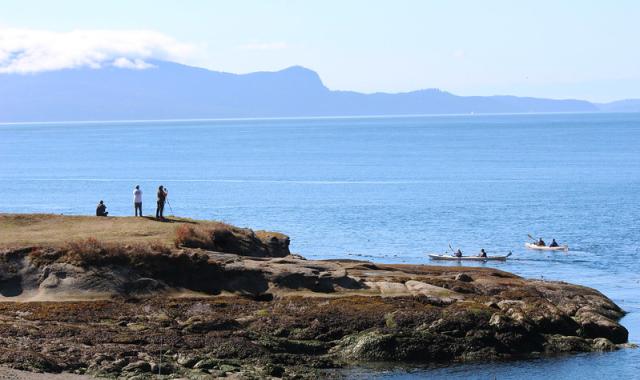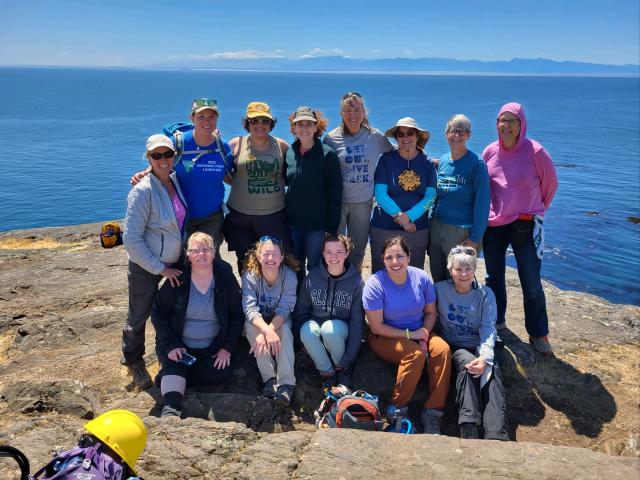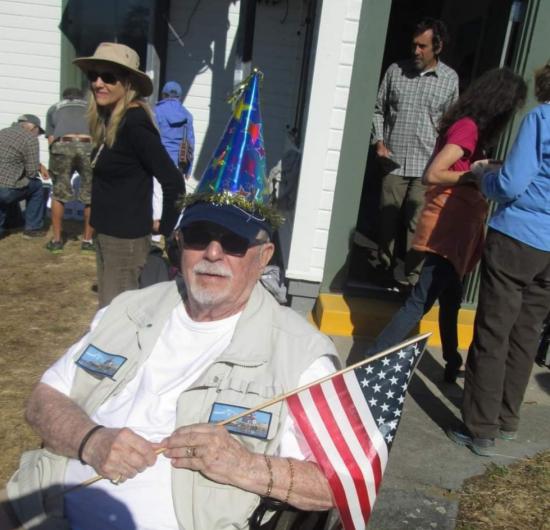Local volunteers are the rock of the San Juan Islands National Monument
Located in Washington state’s Puget Sound, the San Juan Islands National Monument is a beautiful place where the land and community flourish in harmony. This idyllic atmosphere is thanks to the hard work of local volunteers, who proudly give back to public lands in their backyard.
The Bureau of Land Management manages the Monument, designated in 2013 and encompassing approximately 1,000 acres of the San Juan Islands, a picturesque archipelago of more than 450 islands, rocks, and pinnacles. Besides providing critical habitat and protecting historic and cultural sites, the Monument provides an important recreational resource for residents and visitors alike with opportunities to be on the land such as hiking trails leading to beautiful vistas.
Much of the Monument is remote islands accessible only by small boat. A dedicated group of local volunteers therefore play an important role in helping the BLM manage the public lands within the Monument.
Owen Ellis, BLM outdoor recreation planner, is a staff member assigned to the Monument. He notes that there is a lot of work to accomplish within the Monument. Ellis has approximately 50 volunteers with current volunteer agreements, most of whom live on the San Juan Islands.
“It really helps to have eyes on the ground on a regular basis making sure we know what’s going on out there,” said Ellis.
Some of the volunteer work includes visitor experience monitoring, where volunteers track things such as the number of visitors; the weather; if dogs are off their leash; evidence of fires, illegal camping, graffiti, and trash dumping; and the number of boats in the bay.
“What we're trying to get is an idea of who is using these sites and in what ways,” said Ellis.


Most of the visitor experience monitoring work occurs on Lopez Island, the island where BLM manages the most acreage.
Jack Pedigo is a Lopez Island resident who moved there in 2011. Some of his volunteer roles with BLM have included serving as the volunteer coordinator, having involvement in work parties at the Turn Point Light Station and on Patos Island, serving as the secretary of the Keepers of the Patos Light board, and collecting trail counter data.
“Volunteering here and elsewhere helps me develop new skills, meet new people and be an active part of society...of all the island[s], Lopez Island has the strongest sense of community,” said Pedigo.
In addition to visitor experience monitoring, BLM has a volunteer botanist who fills out detailed plant reports on what’s blooming on the islands as well as volunteers who conduct amateur species monitoring. This data is helpful to land management. For example, BLM works with a nonprofit organization that is conducting a weed survey, and some of that data goes into looking at historic trends.
Mark Mosinski is another San Juan Islands resident and volunteer. His work has included counting washed-up jellyfish on the islands, invasive species management, facilities maintenance, tracking visitation numbers, and trail maintenance.
With a background in botany, Mosinski says it’s “rewarding to teach other volunteers from a local partner organization that co-manages Patos [Island] about ID characteristics and seed development of some of the iconic wildflowers of the San Juan Islands National Monument.”
“Seeing how many different hats [Ellis] wears in his position has made me further appreciate our local national monument and also understand the challenges unique to managing one that is spread out among a handful of different islands and outlaying rocks,” Mosinski added.
Other volunteer work occurs at BLM lighthouses within the Monument. One of these lighthouses is the Patos Island Lighthouse. Located on the corner of the United States and Canadian boundary waters, the lighthouse was constructed in 1893 and today serves as an active navigation aid to ships and vessels. Volunteers donate their services at the lighthouse and grounds through the non-profit organization, Keepers of the Patos Light. Some of their work includes providing educational materials and activities at the lighthouse and giving tours of the lighthouse structure. Volunteers also pick up branches and clear the trails on the 270-acre island.
Denise Wilk, KOPL president, has volunteered for BLM for 23 years. She says that in 2024, more than 55 volunteers donated more than 1,000 hours in service to the 889 visitors to Patos Island.
“Volunteers are the lifeblood of service,” said Wilk. “We fill in the blanks. Our volunteers do a tremendous amount of physical and educational work.”


BLM also manages the Turn Point Light Station on Stuart Island. Docents at the light station conduct tours during the summer season and help with maintaining the historic structures.
“Without volunteers, the buildings could not be open, and all the visitors could do would be to wander the grounds,” noted Mike Jonas from the Turn Point Lighthouse Preservation Society.
Some of the Monument’s volunteers have been stewarding these lands for many years.
Roseamber (Rosie) Sumner has been involved in volunteer efforts since before the area became a National Monument in 2013. Sumner has lived on Lopez Island since 1978 and has been volunteering off and on there since the 1980s. She was part of a group who would walk the land, pick up trash, ask dog owners to keep their dogs on a leash, talk to and count visitors, make sure trails were clear, and check for signs of fire, camping, or woodcutting. Sumner later worked for BLM as a seasonal front country ranger from 2013-2018, helping to monitor the land with other volunteers.
Now retired, Sumner said she continues to conduct monitoring activities approximately once a month.
“I love being on the land, talking about the land and expressing gratitude and respect for the Indigenous Tribes who lived and thrived here before us; it is what heals and sustains me. I love seeing how it does this for other humans as well. Protecting our natural resources is paramount to our continued peace and happiness,” said Sumner.
To be sure, the group of local volunteers play an important role in helping the BLM manage the Monument—serving as the critical caretakers while joyfully sharing the beauty of their island home with all who come to visit this special place.
Anyone interested in volunteering with the Monument is encouraged to contact oellis@blm.gov to inquire about current opportunities.
Meredith Black, Public Affairs Specialist
Related Stories
- Celebrating volunteers across the Colorado River District
- BLM recreation sites available to all: Exploring accessibility on Arizona’s public lands
- Overcoming challenges to move the BLM forward: Nikki Haskett
- A day in the life of a BLM Hobbs Petroleum Engineering Technician
- BLM Recreation Sites Available to All: Exploring Accessibility on Alaska’s Public Lands
Office
650 Mullis Street Suite 100
Friday Harbor, WA 98250
United States
